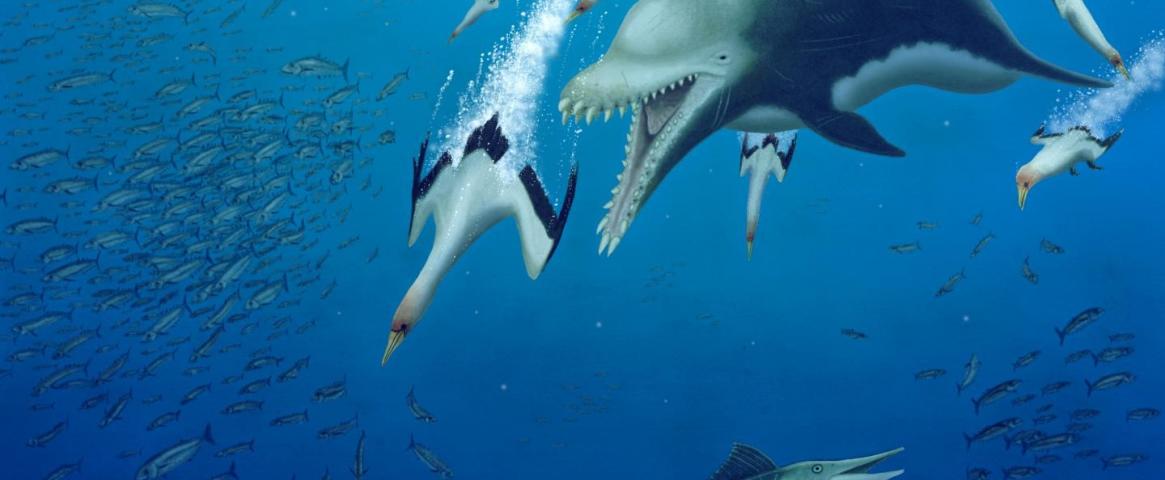By Justin Agan
More than 20 million years ago, before the arrival of sperm whales, orcas, and modern dolphins, a top predator shared important traits with all these memorable species. By examining this ancient dolphin’s features, researchers established that dolphin and whale species separated in their evolution earlier than previously thought and then continued to evolve in parallel over time.
New research from College of Charleston paleontologists, published July 9, is the first to describe a nearly full skeleton of the large dolphin. At fifteen feet long, it was one of the first known echo-locating mammals and probably hunted big prey with its impressively strong bite. It lived between almost 40 million years and 23 million years ago, in a period known as the Oligocene Epoch. The researchers say its existence suggests that dolphins and whales diverged in their evolution much earlier than previously thought.
The researchers found multiple features in the skull, teeth, flippers, spine, and tail that point to the parallel evolution – separate but similar – of toothed whales (a group that includes dolphins and orcas) and modern baleen whales like the blue whale.
In today’s cetaceans, “the humerus is usually less than half the length of the forearm. That is not the case here,” says Robert Boessenecker, a post-doctoral researcher at the College of Charleston and one of the study authors. “It means that the extreme shortening of the humerus evolved independently in modern baleen whales and dolphins.”

Until now, the two groups were thought to have evolved together for a much longer time before splitting into different groups millions of years closer to today. This study shows that the split happened much further back and the two groups have been evolving similar features on their own ever since.
Known as convergent evolution, this phenomenon demonstrates how environments, in this case the ocean, can drive similar evolutions in different species. By the time the toothed whales and baleen whales started evolving separately, Boessenecker says he thinks “they were sort of irretrievably locked into the same evolutionary pathway.” That’s his explanation for why they continued to evolve in parallel.
The nearly complete skeleton isn’t a totally unknown species, the researchers found. The first fossil of this dolphin was a partial skull bone. It was originally put into the genus Squalodon, a waste bin genus, because of the poor condition of the fossil. “Waste bin” genera were used in the past when researchers were unsure where to classify new species.
After studying this more complete specimen, Boessenecker and his colleagues have reclassified the dolphin into the new genus Ankylorhiza. This specimen was originally discovered in South Carolina during the 1990s. It was held in the Mace Brown Museum of Natural History until it could be studied.

Examining the skeleton also led the researchers to conclude that Ankylorhiza tiedemani comb n. was an apex predator of its time. The species was “very clearly preying upon large-bodied prey like a killer whale [does today],” the researchers write. The researchers also state that this is the first known dolphin to use echolocation.
“It was a good start for the authors to make comparisons between the new specimen and killer whales,” says Ewan Fordyce, a vertebrate paleobiologist and professor at the University of Otago in New Zealand.
But because Ankylorhiza has a long snout, Fordyce says that the dolphin might have been fishing for faster prey than the killer whale, which primarily eats larger fish and mammals. “One thing the jaws could have done very effectively is get the initial grab of some prize,” he says.
More fossils found in the same area are awaiting study, including some juveniles of the same species that will give researchers more information about how they grew. Boessenecker also says there is a second species that hasn’t been named yet among the fossils, so there are probably more mysteries of the ancient deep waiting on museum shelves.
Justin Agan is a USMC veteran and graduate student in Texas A&M University’s College of Veterinary Medicine and Biomedical Sciences, Science & Technology Journalism master’s degree program. He is also a graduate assistant for Texas A&M’s Department of Oceanography, where he is a contributing writer for their communications office and assists in social media management. He earned his undergraduate degree in Wildlife & Fisheries Science w/Vertebrate Zoology emphasis from Texas A&M as well. Connect with Justin on LinkedIn at www.linkedin.com/in/justin-agan-a96b11170 or email him at j.agan_07@tamu.edu.
This story was produced as part of NASW's David Perlman Summer Mentoring Program, which was launched in 2020 by our Education Committee. Agan was mentored by Kat Eschner.




